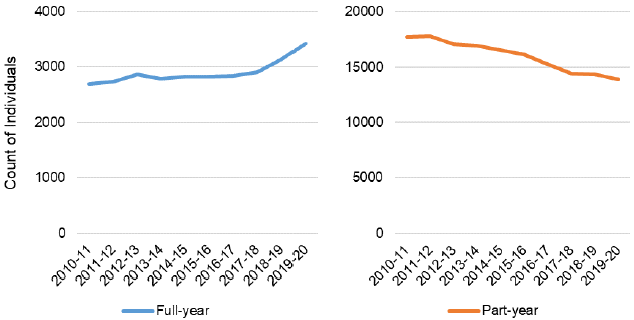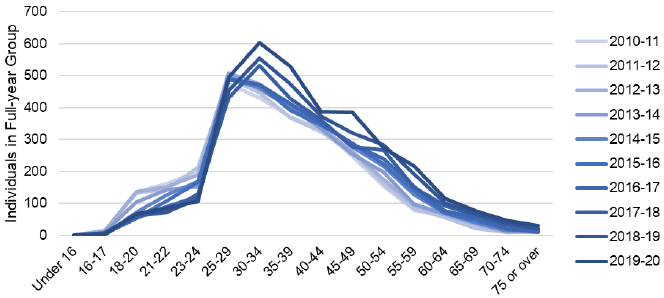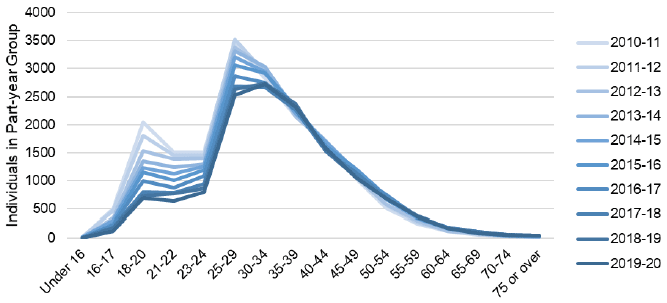Scottish prison population: statistics 2019 to 2020
This publication explores the characteristics of imprisoned people in Scotland. Following several years of sustained decrease, the prison population has risen sharply since 2017-2018 to an annual average of around 8,200 in 2019-2020.
This document is part of a collection
5 Full- and Part-year Populations
(Data table B1)
Most of the prison population is not static. Individuals move in and out of the prison population on a daily basis.
For analysis in this report, individuals have been divided into two broad categories: those who arrive or depart[17] one or more times in the course of the period of analysis (the "part-year" group); and those who remain in prison over the full period (the "full-year" group).
In the absence of sentencing information, the full-year group provides a potentially usful proxy for those individuals on longer sentences, comprising those individuals who spend a whole year or more in prison overall.
- In 2019-20, the full-year group consisted of 3,417 individuals who spent the entire year in Scottish prisons, while 13,877 made up the part-year group
- In 2019-20, this full-year group was around 27% larger than in 2010-11, when 2,699 people spent the entire year in custody
- The part-year group was around 22% smaller than in 2010-11, when 17,708 individuals moved into and/or out of custody one or more times in the year
| Financial Year | Total People | Full-year | % Full-year | Part-year | % Part-year |
|---|---|---|---|---|---|
| 2010-11 | 20,407 | 2,699 | 13.2 | 17,708 | 86.8 |
| 2011-12 | 20,535 | 2,730 | 13.3 | 17,805 | 86.7 |
| 2012-13 | 19,922 | 2,861 | 14.4 | 17,061 | 85.6 |
| 2013-14 | 19,712 | 2,786 | 14.1 | 16,926 | 85.9 |
| 2014-15 | 19,334 | 2,831 | 14.6 | 16,503 | 85.4 |
| 2015-16 | 18,969 | 2,822 | 14.9 | 16,147 | 85.1 |
| 2016-17 | 18,105 | 2,839 | 15.7 | 15,266 | 84.3 |
| 2017-18 | 17,338 | 2,909 | 16.8 | 14,429 | 83.2 |
| 2018-19 | 17,447 | 3,135 | 18 | 14,312 | 82 |
| 2019-20 | 17,294 | 3,417 | 19.8 | 13,877 | 80.2 |
5.1 The Increasing Full-year Population
Figure 15 shows that full-year population levels were broadly constant between 2010-11 and 2016-17, but that there has been a rapid increase in the number of prisoners counted in the full-year group in 2018-19 and 2019-20: +226 people (+8%) and +282 people (+9%) respectively.
By contrast, over the past ten years, the part-year population has fallen more or less continuously by around 22% overall. Thus it appears it is the increase in the full-year population that has driven the recent sharp increase in the prison population overall.

It is likely that a number of factors have led to the observed shifts in the patterns of full- and part-year populations. The changes described above may reflect the multitude of legislative and policy changes implemented across the wider criminal justice system in recent years. The data presented here cannot attest to the impact of these on their own, but the context is important to consider in interpreting the patterns above.
For example, in terms of sentencing, the presumption against short term prison sentences was introduced in 2011, and extended to include custodial sentences of 12 months or less in 2019, with the aim of reducing ineffective use of custody and encourage community based sentences addressing offending and rehabilitation. Changes in sentencing practices over time are observed in the Criminal Proceedings in Scotland 2018-19 report,[18] with a steady increase in custodial sentences of more than one year.
Changes to release arrangements can impact the prison population. Automatic early release for longer term prisoners ended in 2015 and use of home detention curfew for short term prisoners[19] was substantially reduced in 2018. Audit Scotland have also highlighted the stretching of financial resources and staff due to rising prisoner numbers as adversely affecting re-offending/rehabilitation programme completion and preventing prisoners from qualifying for release on parole.[20]
Scottish Government Justice Analytical Services provide ongoing monitoring and modelling of change within the justice system. Recent analysis[21] suggests that the above factors, in combination with historical improvements in clear-up and conviction rates, have impacted on the size and nature of the prison population.
However, modelling change also suggests that shifts in full- and part-year populations may reflect changes in the nature of offending coming to the attention of justice agencies, whether through shifting social norms and values and/or direct changes to legislation on criminal offences. The most recent Criminal Proceedings in Scotland 2018-19 release points to substantial rises in convictions for sexual offences (including rape and attempted rape) where the imposition of custodial sentences is highly likely.[22]
Examining the offence categories that prisoners received their custodial sentence(s) for and the length of sentences being served would allow further exploration of the role of these factors in the observed shifts in full- and part-year populations. However, at present it is not possible to provide historical information from the available data on offence types and sentence length. Scottish Government Justice Analytical Services are working to provide breakdown and analyses of these in the near future.
5.2 Demographic differences in full- and part-year populations
(Data table B5)
As the size of the full-year population changed, so did the age distribution of the people in this group. There is a fairly large reduction in the number of people under 25 in this group, even as the size of the full-year group is relatively stable in between 2010-11 and 2016-17 (Figure 16). From 2017-18 onwards, the number of people aged 30-39 increases relatively quickly. Throughout this time series, the number of people aged 50+ increases continuously.
As the part-year population decreases, we can observe that this reduction occurs mostly among people aged under 35 (Figure 17).


Contact
Email: justice_analysts@gov.scot
There is a problem
Thanks for your feedback